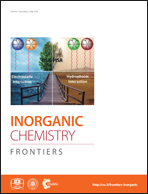Study of single and double chain surfactant–cobalt(iii) complexes and their hydrophobicity, micelle formation, interaction with serum albumins and antibacterial activities†
Abstract
To develop surfactant based metallodrugs, it is important to know the role of the tail part of the surfactant–metal complexes in their hydrophobicity, micellization behaviour, interaction with biomacromolecules and cell penetration. Here, we have taken a new series of single and double chain surfactant–cobalt(III) complexes with alkylamine ligands of different chain length, [Co(dien)(DA)Cl2]ClO4 (1), [Co(dien)(HA)Cl2]ClO4 (2), [Co(dien)(DA)2Cl](ClO4)2 (3) and [Co(dien)(HA)2Cl](ClO4)2 (4), where dien = diethylenetriamine, DA = dodecylamine and HA = hexadecylamine. The complexes were characterised by elemental analysis, NMR, ESI-MS, UV-visible and FTIR techniques. In addition, the average size distribution and morphology of self-assembled surfactant–cobalt(III) complexes were examined by DLS and SEM, respectively. The hydrophobicity, critical micelle concentration (CMC) values, thermodynamics of micellization (ΔG°m, ΔH°m and ΔS°m) and the nature of the interaction of these complexes with bovine and human serum albumins (BSA/HSA) were evaluated. The obtained CMC values were in the order 1 > 2 > 3 > 4, indicating that double chain systems have lower CMC values compared to single chain systems due to the increase in the hydrophobicity of the alkyl amine ligands. The thermodynamics of micellization indicated that the process is spontaneous, exothermic and entropy driven. The interaction of complexes 1–4 with serum albumins indicated that the quenching process follows a static mechanism, and the extent of quenching and binding parameters were in the order 1 < 2 < 3 < 4. Interestingly, on increasing the temperature, the protein–complex stability decreased for the single chain systems, and increased for the double chain systems, probably due to the involvement of electrostatic and hydrophobic interactions. This was further supported by the thermodynamics of protein interaction and synchronous fluorescence studies. Moreover, the results from UV-vis, synchronous and circular dichroism (CD) showed the occurrence of conformational and micro environmental changes in BSA/HSA. It is also noted that BSA has more binding affinity with surfactant–metal complexes compared to HSA. Furthermore, the antimicrobial effects of these complexes were investigated by disk diffusion method; complex 4 has a better antimicrobial activity due to the ease of bacterial cell penetration due to its more hydrophobic nature.


 Please wait while we load your content...
Please wait while we load your content...